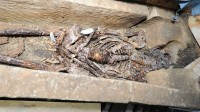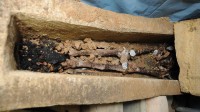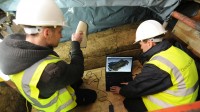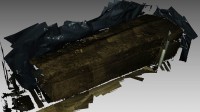 A limestone sarcophagus discovered earlier this year underneath Lincoln Castle during an archaeological survey before construction of an elevator shaft has been opened. It was a lengthy, delicate process. When the stone coffin was first unearthed, only the side was visible. The trench was deep and the sarcophagus very heavy; it took months to dig it out. Finally in October archaeologists were able to gingerly remove the sarcophagus from its berth 10 feet under ground level, sliding it out horizontally.
A limestone sarcophagus discovered earlier this year underneath Lincoln Castle during an archaeological survey before construction of an elevator shaft has been opened. It was a lengthy, delicate process. When the stone coffin was first unearthed, only the side was visible. The trench was deep and the sarcophagus very heavy; it took months to dig it out. Finally in October archaeologists were able to gingerly remove the sarcophagus from its berth 10 feet under ground level, sliding it out horizontally.
The team had hoped that once the lid was exposed they’d find an inscription identifying who was buried within, but they were not so lucky. The lid of the stone coffin was mortared down for burial and since then had cracked all the way across horizontally in two places. In order to lift it, the team had to remove the lid in three sections. Archaeologists had gotten a glimpse of the contents when they threaded an endoscopic camera into the sarcophagus after the initial discovery so they knew it contained an articulated skeleton. When the first section of the lid was removed, they found the remains of leather boots or shoes, a very unusual discovery that confirmed the deceased was someone of great status in the community.
 The mere fact of his having been buried in a sarcophagus indicated he was someone of wealth and/or prestige. The bones have not been radiocarbon dated yet, but pottery found in the same layer as the burials dates to the 10th century, a hundred or so years before the Norman invasion and the construction of Lincoln Castle by William the Conqueror in 1068. It seems William chose the site of an Anglo-Saxon chapel or church upon which to build his castle, a chapel in which the community’s elite were buried. Anglo-Saxons didn’t typically use sarcophaguses to bury the dead. It was probably a Roman-era coffin recycled for a local dignitary, perhaps a king or a religious leader.
The mere fact of his having been buried in a sarcophagus indicated he was someone of wealth and/or prestige. The bones have not been radiocarbon dated yet, but pottery found in the same layer as the burials dates to the 10th century, a hundred or so years before the Norman invasion and the construction of Lincoln Castle by William the Conqueror in 1068. It seems William chose the site of an Anglo-Saxon chapel or church upon which to build his castle, a chapel in which the community’s elite were buried. Anglo-Saxons didn’t typically use sarcophaguses to bury the dead. It was probably a Roman-era coffin recycled for a local dignitary, perhaps a king or a religious leader.
In addition to the one in the sarcophagus, eight other bodies were found in the small 10-by-10-foot space. Seven were buried in wooden coffins, one wrapped in a finely woven woolen shroud and laid to rest in a niche in the foundations of the wall. Archaeologists believe the shrouded burial was a votive, that the man was someone holy and his remains were placed in the foundations of the church to sanctify it.
 Before the lid was removed, experts took a 3D scan of the complete sarcophagus. Once the lid came off, the interior was also 3D scanned. This will allow researchers to examine the burial in detail without risking damage to the human remains or any artifacts that might still be there.
Before the lid was removed, experts took a 3D scan of the complete sarcophagus. Once the lid came off, the interior was also 3D scanned. This will allow researchers to examine the burial in detail without risking damage to the human remains or any artifacts that might still be there.
Mary Powell, Programme Manager for Lincoln Castle Revealed project, said: […]
“Finding a sarcophagus from this period that’s still undisturbed is extremely rare, so this discovery is of national significance.
“The next step will be to thoroughly analyse both the sarcophagus and the remains to learn as much as we can from it. This will undoubtedly increase what we know about Saxon Lincoln.”
 It pretty much has to, because historians know very little about Lincoln after the Romans left and before the Normans came. That’s why the discovery of the church, of which there are no surviving records so nobody even knew it was there, and burials is of national significance.
It pretty much has to, because historians know very little about Lincoln after the Romans left and before the Normans came. That’s why the discovery of the church, of which there are no surviving records so nobody even knew it was there, and burials is of national significance.
They will also attempt a facial reconstruction extrapolated from the remains of the skull, but they have to put it back together first. Judging from the pictures, it looks heavily damaged.
Lightening some of the Dark Ages, then … Absolutely fascinating. If only I could rid myself of some scepticism regarding facial reconstruction …
Aye, let’s wait and see what structures and artefacts they find in (and on) the sarcophagus. That massive block around the cranium, from this angle, almost looks similar to that of a roman latrine, which does not mean that it used to be one, but the stonecutter probably knew how to carve a toilet. Are the whitish bits and pieces metal ? At last, the planned scientific facial reconstruction will probably reveal a bearded Anglo-Saxon.
I feel bad for the people who got their burial grounds disturbed by WIlliam the Conqueror in 1068 after he built the Lincoln Castle. But this is a great discovery for mankind’s history.
meadnova.wordpress.com